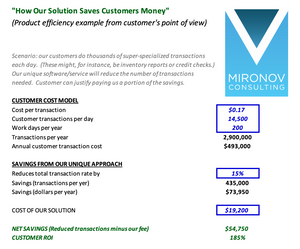One of the first things I ask about with a new product team is “how will a customer justify paying for your product?”
An apparently simple question, but I often get blank stares. Here’s a thumbnail of the problem and the process, along this a tiny spreadsheet template:
Problem
Your intended buyer isn’t the CEO, but instead some line employee or manager. Every sizeable purchase order has to be explained and justified and “ROI’d”. If you don’t help your intended buyer explain the specific savings that come from buying your product, it’s much harder to get a purchase approved. So part of your ‘sales enablement’ job is to give the buyer (the customer) a simple tool to quantify savings. In this situation, only numbers and dollars count – you’re not allowed to justify purchases based on ‘strategic value’ or vague improvement or handwaving.
Starting from the customer’s point of view, you have to show current costs and how your product/service will save the customer money. Or, alternately, how you will help the customer make more money. All of the logic and numbers are from the customer’s side: costs, quantities, numbers of transactions, percent improvement, etc. Savings must be COMPUTED from these inputs in a simple way that the buyer’s CFO would understand. For instance:
- “Our super-special credit scoring application will reduce the number of outside credit checks you have to run. You currently do {insert number} credit checks per year at {insert price}. We’ll reduce that by {insert percentage} for a savings of {compute here}. We will only charge you {insert price} for a net savings of {compute dollars} and ROI of {percent}.”
- “Our super-special cell phone gaskets protect cell phones from damage when your subscribers drop them into puddles or mugs of beer. You currently replace {percent} of subscriber cell phones every year for water damage, each of which costs you {dollars} in parts and support and shipping and wasted time. Using our gaskets, you’ll reduce this by {percent} or {total number per year} for a savings of {dollars}. Gaskets only add {our price per widget} to the phone cost, which is an overall savings of {compute dollars} and ROI of {percent}.”
You get the idea. The details vary, but the approach does not. It’s completely generic. Some tips:
- You’ll need to add your own savings logic as above. Every savings story sounds similar, but the details are specific to your product/service.
- I’ve marked all inputs (entry items) in bold blue italics with colored borders. That makes it easy for a user (customer) to know which are the inputs. Likewise, I’ve ‘protected’ all of the cells that are not inputs. You will need to turn on ‘sheet protection’ to see this work. I’ve left ‘protect’ turned off, since the first thing you’ll probably want to do is edit this worksheet.
- Keep things simple. If you can reduce yours down to only a handful of rows, it is more powerful. Make two versions if necessary. Don’t have branching logic or super-fancy math that you’ll be endlessly explaining to sales reps with ADD.

